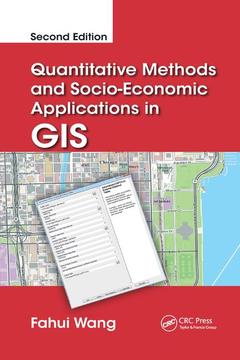Quantitative Methods and Socio-Economic Applications in GIS (2nd Ed.)
Auteur : Wang Fahui

The second edition of a bestseller, Quantitative Methods and Socio-Economic Applications in GIS (previously titled Quantitative Methods and Applications in GIS) details applications of quantitative methods in social science, planning, and public policy with a focus on spatial perspectives. The book integrates GIS and quantitative (computational) methods and demonstrates them in various policy-relevant socio-economic applications with step-by-step instructions and datasets. The book demonstrates the diversity of issues where GIS can be used to enhance the studies related to socio-economic issues and public policy.
See What?s New in the Second Edition:
- All project instructions are in ArcGIS 10.2 using geodatabase datasets
- New chapters on regionalization methods and Monte Carlo simulation
- Popular tasks automated as a convenient toolkit: Huff Model, 2SFCA accessibility measure, regionalization, Garin-Lowry model, and Monte Carlo based spatial simulation
- Advanced tasks now implemented in user-friendly programs or ArcGIS: centrality indices, wasteful commuting measure, p-median problem, and traffic simulation
Each chapter has one subject theme and introduces the method (or a group of related methods) most relevant to the theme. While each method is illustrated in a special case of application, it can also be used to analyze different issues. For example, spatial regression is used to examine the relationship between job access and homicide patterns; systems of linear equations are analyzed to predict urban land use patterns; linear programming is introduced to solve the problem of wasteful commuting and allocate healthcare facilities; and Monte Carlo technique is illustrated in simulating urban traffic.
The book illustrates the range of computational methods and covers common tasks and major issues encountered in a spatial environment. It provides a platform for learning technical skills and quantitative methods in the context of addressing real-world problems, giving you instant access to the tools to resolve major socio-economic issues.
PART I. GIS AND BASIC SPATIAL ANALYSIS TASKS. Chapter 1. Getting Started with ArcGIS: Data Management and Basic Spatial Analysis Tools. Chapter 2. Measuring Distances and Time. Chapter 3. Spatial Smoothing and Spatial Interpolation. PART II. BASIC QUANTITATIVE METHODS AND APPLICATIONS. Chapter 4. GIS-Based Trade Area Analysis and Applications in Business Geography. Chapter 5. GIS-Based Measures of Spatial Accessibility and Application in Examining Healthcare Access. Chapter 6. Function Fittings by Regressions and Application in Analyzing Urban and Regional Density Patterns. Chapter 7. Principal Components, Factor Analysis and Cluster Analysis and Application in Social Area Analysis. PART III. ADVANCED QUANTITATIVE METHODS AND APPLICATIONS.Chapter 8. Geographic Approaches to the Small Population Problem and Application in Cancer Data Analysis. Chapter 9. Spatial Statistics Analysis and Applications in Toponymical and Crime Studies.Chapter 10. Linear Programming and Applications in Examining Wasteful Commuting and Allocating Healthcare Providers.Chapter 10. Linear Programming and Applications in Examining Wasteful Commuting and Allocating Healthcare Providers. Chapter 12. The Cellular Automata Model and Application in Simulating Urban Growth. Chapter 12. The Cellular Automata Model and Application in Simulating Urban Growth. Reference.Index.
Date de parution : 08-2017
15.6x23.4 cm
Thèmes de Quantitative Methods and Socio-Economic Applications in GIS :
Mots-clés :
Case Study; Floating Catchment Area Method; Computational methods; MONTE CARLO; GIS; Dialog Window; Geographic Information Science; Floating Catchment Area; Geographic Information Systems; Place Name; Quantitative methods; Travel Time; Spatial analysis; Transportation Network; Spatial statistics; Open Attribute Table; Input Feature Class; Census Tracts; Output Feature Class; Garin Lowry Model; Table Dist; POPULATION DENSITY PATTERN; 2SFCA Method; Huff Model; Linear Equation; Spatial Cluster Analysis; Google Map API; Spatial Error Model; Linear Programming; Late Stage Breast Cancer; Zip Code Areas; Social Area Analysis



